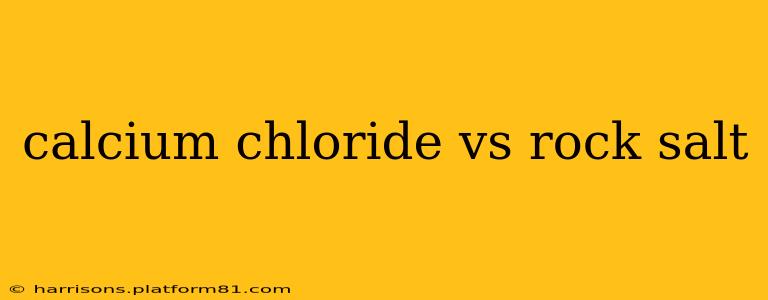Winter's icy grip can wreak havoc on roads and sidewalks, making them treacherous for pedestrians and vehicles alike. The battle against ice typically pits two main contenders against each other: calcium chloride and rock salt (sodium chloride). Both effectively melt ice, but they differ significantly in their properties, effectiveness, and environmental impact. This in-depth comparison will explore the key differences between calcium chloride and rock salt, helping you make an informed decision for your de-icing needs.
What is Calcium Chloride?
Calcium chloride (CaCl₂) is a chemical compound that's highly hygroscopic, meaning it readily absorbs moisture from the air. This property, coupled with its exothermic reaction with ice (releasing heat), makes it a powerful de-icer, even at very low temperatures. It's often favored for its effectiveness in extremely cold conditions where rock salt struggles.
What is Rock Salt (Sodium Chloride)?
Rock salt, or sodium chloride (NaCl), is the common table salt we use in our kitchens. It's a readily available and inexpensive de-icer, making it a popular choice for many homeowners and municipalities. However, its effectiveness is limited by temperature; it becomes significantly less effective below 20°F (-7°C).
Calcium Chloride vs. Rock Salt: Key Differences
Here's a breakdown of the key differences between calcium chloride and rock salt:
Melting Point and Effectiveness at Low Temperatures:
- Calcium Chloride: Melts ice at significantly lower temperatures than rock salt, remaining effective even down to -25°F (-32°C). This superior performance in extreme cold makes it ideal for harsh winter climates.
- Rock Salt: Becomes less effective below 20°F (-7°C). At very low temperatures, it may not melt ice effectively, or may only slow the rate of ice formation.
Environmental Impact:
- Calcium Chloride: While less harmful to the environment than some other de-icers, it can still impact soil and waterways. Excessive use can lead to increased salinity and affect plant growth. It also has a higher corrosiveness than rock salt.
- Rock Salt: Contributes to soil and water salinity, impacting plant life and aquatic ecosystems. It's also corrosive to concrete and metal.
Cost:
- Calcium Chloride: Generally more expensive than rock salt. The higher cost is often justified by its superior performance in extreme cold conditions and its ability to melt ice more quickly and efficiently.
- Rock Salt: Significantly cheaper than calcium chloride, making it an attractive option for large-scale applications where budget is a primary concern.
Corrosion:
- Calcium Chloride: More corrosive to metal than rock salt.
- Rock Salt: Corrosive, but less so than calcium chloride.
Which is better for the environment?
Both calcium chloride and rock salt have environmental drawbacks. The "better" option depends on several factors, including the quantity used, the specific environmental context (soil type, water systems), and the overall impact compared to other de-icing methods. Minimizing the use of both is crucial for environmental protection.
Is calcium chloride pet-safe?
While calcium chloride is less toxic than many other de-icing agents, ingestion can still cause gastrointestinal irritation in pets. It's crucial to keep pets away from treated areas and to thoroughly clean paws after walks on treated surfaces.
Which is better for concrete?
Both calcium chloride and rock salt can damage concrete over time due to their corrosive nature. However, calcium chloride is generally considered more damaging.
Which is better for cars?
Both can cause corrosion on vehicles, with calcium chloride posing a higher risk. Regular washing and protective coatings can help mitigate the damage.
Which de-icer melts ice faster?
Calcium chloride generally melts ice faster than rock salt, especially at lower temperatures. Its exothermic reaction with ice generates heat, accelerating the melting process.
Conclusion
The choice between calcium chloride and rock salt depends on your specific needs and priorities. For extreme cold climates where effectiveness is paramount, calcium chloride's superior performance justifies its higher cost. However, in milder climates where budget is a major concern, rock salt remains a viable option. Regardless of your choice, responsible use and awareness of the environmental implications are critical. Minimizing the amount used and exploring alternative de-icing methods, such as sand or grit, should always be considered to reduce the impact on the environment and infrastructure.
